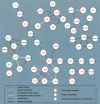Genome sequence of Haloarcula marismortui: a halophilic archaeon from the Dead Sea
- PMID: 15520287
- PMCID: PMC525680
- DOI: 10.1101/gr.2700304
Genome sequence of Haloarcula marismortui: a halophilic archaeon from the Dead Sea
Erratum in
- Genome Res. 2004 Dec;14(12):2510
Abstract
We report the complete sequence of the 4,274,642-bp genome of Haloarcula marismortui, a halophilic archaeal isolate from the Dead Sea. The genome is organized into nine circular replicons of varying G+C compositions ranging from 54% to 62%. Comparison of the genome architectures of Halobacterium sp. NRC-1 and H. marismortui suggests a common ancestor for the two organisms and a genome of significantly reduced size in the former. Both of these halophilic archaea use the same strategy of high surface negative charge of folded proteins as means to circumvent the salting-out phenomenon in a hypersaline cytoplasm. A multitiered annotation approach, including primary sequence similarities, protein family signatures, structure prediction, and a protein function association network, has assigned putative functions for at least 58% of the 4242 predicted proteins, a far larger number than is usually achieved in most newly sequenced microorganisms. Among these assigned functions were genes encoding six opsins, 19 MCP and/or HAMP domain signal transducers, and an unusually large number of environmental response regulators-nearly five times as many as those encoded in Halobacterium sp. NRC-1--suggesting H. marismortui is significantly more physiologically capable of exploiting diverse environments. In comparing the physiologies of the two halophilic archaea, in addition to the expected extensive similarity, we discovered several differences in their metabolic strategies and physiological responses such as distinct pathways for arginine breakdown in each halophile. Finally, as expected from the larger genome, H. marismortui encodes many more functions and seems to have fewer nutritional requirements for survival than does Halobacterium sp. NRC-1.
Figures




References
-
- Aravind, L. and Ponting, C.P. 1997. The GAF domain: An evolutionary link between diverse phototransducing proteins. Trends Biochem. Sci. 22: 458-459. - PubMed
-
- Baliga, N.S., Goo, Y.A., Ng, W.V., Hood, L., Daniels, C.J., and DasSarma, S. 2000. Is gene expression in Halobacterium NRC-1 regulated by multiple TBP and TFB transcription factors? Mol. Microbiol. 36: 1184-1185. - PubMed
WEB SITE REFERENCES
-
- http://halo.systemsbiology.net; Sequence, data, annotations, and analyses.
-
- http://www.ebi.ac.uk/interpro/README1.html); InterProScan.
-
- http://www.genome.ad.jp/kegg-bin/srch_orth_html; KEGG database.
-
- http://ncbi.nih.gov/COG; COG.
Publication types
MeSH terms
Substances
Associated data
- Actions
- Actions
- Actions
- Actions
- Actions
- Actions
- Actions
- Actions
- Actions
LinkOut - more resources
Full Text Sources
Other Literature Sources
Molecular Biology Databases
Miscellaneous
